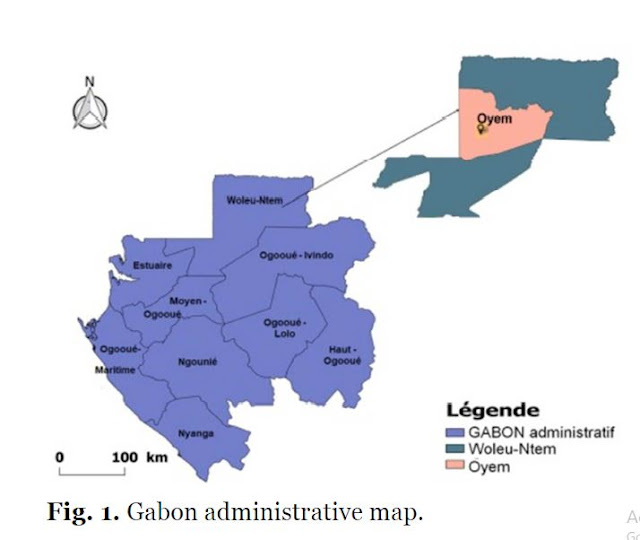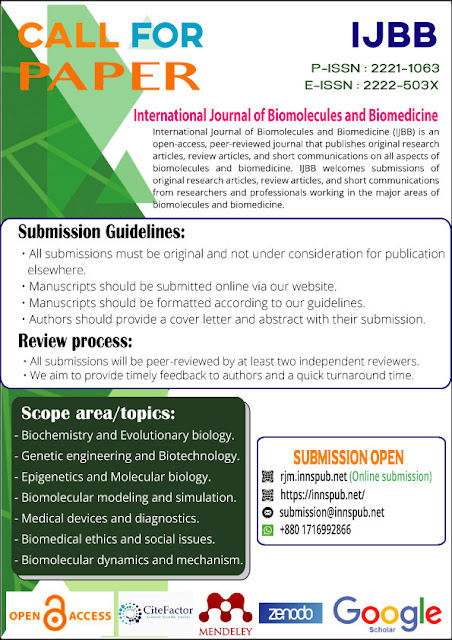Wensleslace Landry Mve
Mendame , Boris Achille Eyi Mintsa , Alban-Michel Nguema Nguema , Arnaud
Brice Pambo Pambo and ET Ibrahim from the different institute of
the Gabon. wrote a research article about Traditional Healing:
Acalypha Wilkesiana for Arterial Hypertension entitled," Ethnobotanical
study of Acalypha wilkesiana (Euphorbiaceae), a plant used in the treatment of
arterial hypertension in Oyem in Northern Gabon." This researach
paper published by the International Journal of Biomolecules and Biomedicine|IJBB an open access scholarly researcj journal on Biomedicine under the
affiliation of the International Network For Natural Sciences
|INNSpub, an open access multidisciplinary research journal publisher.
Abstract
Cardiovascular diseases, in particular arterial hypertension, are one of the causes of mortality and morbidity in the world, the impact of the treatment is very important, for this the poor populations have difficulties and turn to traditional therapists for treat these pathologies using plants. Thus, our investigations on the use of plants, in the form of an ethnobotanical survey, were carried out in the town of Oyem with 50 people questioned, composed of men (84%) and women (16%) with an age varying between 43 and 75 years. At the end of this investigation, 10 plants were inventoried but Acalypha wilkesiana which is the main object because of its high frequency of use will be studied in particular. The species A. wilkesiana is used to treat several conditions, particularly hypertension. Regarding the organs, the leaves are the most used parts of the plant (93%). The treatment is administered in the form of a decoction (54%) and maceration (40%). These results constitute a database for carrying out phytochemical and biological tests in the search for new bioactive antihypertensive molecules in plants.
Read more: Cloning and Expression of Human GAD65 Gene in E. coli | InformativeBD
Introduction
The effectiveness of phytotherapy is proven and it shealth benefits have allowed traditional medicine to enter our habits (Bene et al., 2016). Nowadays, the use of traditional herbal medicine is experiencing renewed interest in Western countries, particularly to treat the imbalances caused by modern life (Adomouet al., 2012; Bene et al., 2016).
Indeed, some work (Olou et al., 2018) has shown that plants were used not only for their nutritional values but also for their properties in the treatment of certain pathologies such as cardiovascular diseases.
However, despite the efforts made in this area, cardiovascular diseases are one of the leading causes of death worldwide. More than 80% of deaths from cardiovascular diseases occur in developed and developing countries (WHO, 2011).
High blood pressure is one of the cardiovascular diseases that currently affects more than a quarter of the world's population. Worldwide, the total number of people affected would increase from 171 million in2000 to 366 million in 2030 if nothing is done (Ueliet al., 2008).
The prevalence of hypertension in sub-Saharan Africais very high among adults aged 18 and over, varying between 16% and 40%. This prevalence is over 60% in people over 65 (Houehanou et al., 2018). In Gabon, Mipinda et al. (2013) report that high blood pressure affects 22.64% of the population.
In view of this health contact, the lack of specialists, the scarcity or non-existence of health centers and the high cost of pharmaceutical products, populations resort to traditional medicine using plants. The promotion of traditional medicine is thus of growing interest, because according to the WHO (2011), nearly80% of populations depend on traditional medicine.
The objective
of this work is to give a scientific basis to Acalypha wilkesiana in the
treatment of arterial hypertension through an ethnobotanical investigation.
Reference
Adomou AC, Yedomonhan
H, Djossa B, Legba SI, Oumorou M, Akoegninou A. 2012. Étude Ethnobotanique
des plantes médicinales vendues dans le marché d’Abomey Calavi au Bénin.
International Journal of Biology and Chemestry Science 6, 745-772.
Aladejimokun AO,
Daramola KM, Osabiya OJ, Arije OC. 2017. Comparative Study of
Phytochemical Constituents and Antimicrobial Activities of Acalypha
wilkesiana and Acalypha godseffiana Extracts. Journal of
Advanced Microbiology 4, 2456-7116.
Béné K, Camara D, Fofie
NBY, Kanga Y, Yapi AB, Yapo YC, Ambe SA, Zirihi GN. 2016. Étude
ethnobotanique des plantes médicinales utilisées dans le Département de
Transua, District du Zanzan (Côte d’Ivoire). Journal of Animal & Plant Sciences 27, 4230-4250.
Bruneton J. 1999.
Pharmacognosie, Phytochimie, Plantes Médicinales. Editions TEC & DOC: Paris
783-785.
Chanet A, Milenkovic D,
Manach C, Mazur A, Morand C. 2012. Citrus flavanones: what is their role
in cardiovascular protection? Journal of Agricol Food Chemistry 60, 8809-8822.
Del Rio D,
Rodriguez-Mateos A, Spencer JP, Tognolini M, Borges G, Crozier A. 2013.
Dietary (poly) phenolics in human health: structures, bioavailability, and
evidence of protective effects against chronic diseases. Antioxid Redox
Signal 18, 1818-1892.
Dibong SD,
Mpondo-Mpondo E, Ngoye A, Kwin MF, Betti JL. 2011. Ethnobotany and
phytomedicine of medicinal plants sold in Douala markets. Journal of Applied
Biosciences 37, 2496-2507.
Gonzales MM, Tarumi T,
Tanaka H, Sugawara J, Swann-Sternberg T, Goudarzi K, Haley AP. 2010.
Functional imaging of working memory and peripheral endothelial function in
middle-aged adults. Brain and Cognition 73, 146-151.
Houehanou C, Amidou S,
Preux PM, Houinato D, Lacroix P. 2018. Hypertension artérielle (HTA) en
Afrique subsaharienne. Journal de Médecine vasculaire 43, 87.
Ibrahim B, Attéké NC,
Moungengui S, Lépengué NA, Issembé AY, Nsi Akoué G, Souza A, M’batchi B. 2015.
Medicinal and aromatic plants 5.
Morand C, Milenkovic
D. 2014. Polyphénols et santé vasculaire : mise en évidence du rôle direct
des polyphénols dans les effets bénéfiques des agrumes dans la protection
vasculaire. Innovations Agronomiques 42, 47-62.
Mpondo EM, Didier SD,
Richard JP, Alfred N, Christelle FLY. 2012. Etude actuelle de la médecine
traditionnelle dans le système de santé des populations rurales et urbaines de
Douala (Cameroun). Journal of Applied Biosciences 55, 4036- 4045.
N’Guessan K, Beugré K,
Guédé NZ, Dossahoua T, Laurent A. 2009. Screening phytochimique de
quelques plantes médicinales ivoiriennes utilisées en pays Krobou (Agboville,
Côte-d’Ivoire). Sciences & Nature 6, 1-15.
Nsi Akoué G. 2017.
Etude des plantes médicinales et/ou alimentaires issues du régime alimentaire
du mandrill (Mandrillus sphinx) : approche zoopharmacognosie. Thèse de
doctorat, Université de Sciences et Techniques de Masuku, Gabon 105-110.
Nworgu ZAM, Ameachina
FC, Owolabi J, Otokiti I, Ogudu U. 2011. Cardiovascular Effects of Aqueous
Extract of Acalypha Wilkesiana Hoffmannii Leaves In Rabbits And Rats.
Nigerian Journal of Pharmacology Science 10, 45-50.
Odoh UE, Ndubuokwu RI,
Inya-Agha SI, Osadebe PO, Uzor PF, Ezejiofor M. 2014. Antidiabetic
activity and phytochemical screening of Acalypha wilkesiana (Euphorbiaceae)
Mull Arg. roots in alloxan-induced diabetic rats. Science Research Essays 9, 204-212.
Organisation Mondiale
de la Santé. 2011. Gouvernance santé et population. Stratégie OMS de
coopération avec les pays en développement p. 5.
Ouattara D. 2006.
Contribution à l’inventaire des plantes médicinales significatives utilisées
dans la région de Divo (sud forestier de la Côte d’Ivoire) et à la diagnose du
poivrier de Guinée : Xylopia aethiopica (Dunal) A. Rich.
(Annonaceae). Thèse de doctorat, Université de Cocody Abidjan, Côte d’Ivoire
184.
Sereme A, Millogo-Rasolodimby
J, Guinko S, Nacro M. 2008. Propriétés thérapeutiques des plantes a tanins
du Burkina Faso. Pharmacopée et Médecine Traditionnelle Africaines 15, 41-44.
Ueli Z, Lic P, Bopp M. 2008.
Chiffres et données sur les maladies cardiovasculaires en Suisse. Fondation
Suisse de Cardiologie 1-47.











%20in%20full.JPG)


0 comments:
Post a Comment